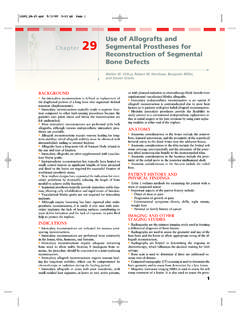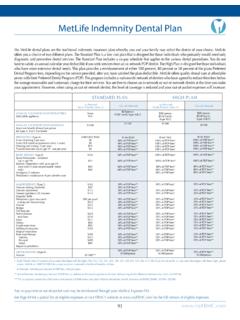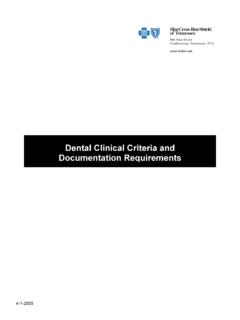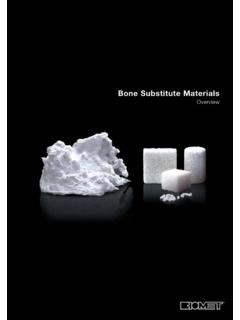Transcription of Crown Lengthening Procedures- A Review Article
1 IOSR Journal of Dental and Medical Sciences (IOSR-JDMS) e-ISSN: 2279-0853, p-ISSN: 14, Issue 4 Ver. I (Apr. 2015), PP 27-37 DOI: 27 | Page Crown Lengthening procedures - A Review Article Dr. Gunjan Gupta, Dr. Ramesh Gupta, Dr. Nishant Gupta, Dr. Udit Gupta Dentists at Smile by Design- Dr Gupta s Multispeciality Dental Clinic, New Delhi, India I. Introduction Badly mutilated teeth or the grossly decayed teeth often pose problems to the restorative dentists during their treatment due to unavailability of sufficient clinical crowns. Hence a Crown Lengthening procedure prior to restorative treatment is mandatory during management of such teeth. Clinical Crown Lengthening refers to procedures designed to increase the extent of supragingival tooth structure for restorative or esthetic Clinicians often encounter the need for Crown Lengthening in the practice of dentistry and have to make treatment decisions taking into consideration how to best address the biological, functional, and esthetic requirements of each particular case.
2 The concept of Crown Lengthening was first introduced by Cohen (1962)2 and is presently a procedure that often employs some combination of tissue reduction or removal, osseous surgery, and / or orthodontics for tooth exposure. The amount of tooth structure exposed above the osseous crest (about 4mm) must be enough to provide for a stable dentogingival complex and biologic width to permit proper tooth preparation and account for an adequate marginal placement, thus ensuring a good marginal seal with retention for both provisional and final This Article discusses Crown Lengthening as one way in which the dentist can address both functional and esthetic demands Indications1 The indications for Crown Lengthening are: Restorative needs To increase clinical Crown height lost due to caries, fracture or wear To access subgingival caries To produce a ferrule for restoration To access a perforation in the coronal third of the root To relocate margins of restorations that are impinging on biological width.
3 Aesthetics Short teeth Uneven gingival contour Gummy smile. Contra-indications & Limiting Factors4 Inadequate Crown to root ratio Non restorability of caries or root fracture Esthetic compromise High furcation Inadequate predictability Tooth arch relationship inadequacy Compromise adjacent periodontium or esthetics Insufficient restorative space No maintainability Classification Of Aesthetic Crown Lengthening Ernesto has proposed the following classification:5 CLASSIFICATION CHARACTERISTICS ADVANTAGES DISADVANTAGES TYPE I Sufficient soft tissue allows gingival exposure of the tooth without exposure of the alveolar crest and violation of the biologic width. May be performed by the restorative dentist. Provisional restorations of the desired length may be placed immediately TYPE II Sufficient soft tissue allows gingival excision without Will tolerate a temporary violation of the biologic width.
4 Requires osseous contouring. May require a surgical referral. Crown Lengthening procedures - A Review Article DOI: 28 | Page exposure of the alveolar crest but in violation of the biologic width. Allows staging of the gingivectomy and osseous contouring procedures . Provisional restorations of the desired length may be placed immediately TYPE III Gingival excision to the desired clinical Crown length will expose the alveolar crest. Staging of the procedures and alternative treatment sequence may minimize display of exposed subgingival structures. Provisional restorations of desired length may be placed at second stage gingivectomy Requires osseous contouring. May require a surgical referral. Limited flexibility. TYPE IV Gingival excision will result in inadequate band of attached gingiva Limited surgical options.
5 No flexibility. A staged approach is not advantageous. May require a surgical referral. Type I- It characterized by sufficient gingival tissue coronal to the alveolar crest, allowing the surgical alteration of the gingival margin levels without the need for the osseous recontouring. A gingivectomy or gingivoplasty procedure will usually suffice to establish the desired gingival margin position while simultaneously avoiding the violation of biologic width. Type II- It is characterized by soft tissue dimensions that allow the surgical repositioning of the gingival margin without osseous recontouring but nevertheless in violation of the biologic width. This type basically consists of staging of Crown Lengthening procedure in two stages stage 1 and stage 2. In stage one, a gingivectomy procedure is done and required amount of Crown is exposed. Once the tissues are healed stage 2 procedure is done, in which, a flap surgery is done n required amount of ostectomy is done to maintain the biologic width.
6 (Figure 1a-j) (Fig 1a) Pre operative view of type II case (Fig 1b) Red and blue lines indicate current and desired gingival margins level. (Fig 1c) A surgical template is made to provide the periodontist with specific therapeutic parameters with respect to the desired gingival margins and contours. Crown Lengthening procedures - A Review Article DOI: 29 | Page (Fig 1d) The gingivectomy planned for the first stage is performed on the diagnostic model (Fig 1e) The diagnostic wax up incorporated the margins levels anticipated following gingivectomy, and will be the basis for fabrication of provisional restorations. (Fig 1f) Pre operative appearance of the surgical guide during try- in. The amount of soft tissue that will be removed can be easily visualized. (Fig 1g) Appearance of incisions outlining the gingival collars prior to excision (Fig 1h) Exposed Crown margins and root surfaces after the gingivectomy.
7 While the biologic width spaces have been violated, no osseous exposure has resulted. Crown Lengthening procedures - A Review Article DOI: 30 | Page (Fig 1i) Type II cases will tolerate a temporary violation of the biologic width. Upon healing, the provisional is optimized until the objectives desired in the final restoration are achieved. (Fig 1j) The margins of provisional restoration serve as guide during osseous surgery to ensure adequate biologic width space during stage two surgery Type III- In type III bone sounding may reveal a scenario where repositioning of the gingival margin will result in the exposure of the osseous crest. It is inappropriate to refer these patients without providing a surgical template derived from a relevant esthetic blue print. This template would serve as a guide during surgery so that following flap reflection, a constant relationship between anticipated clinical Crown and the osseous crest levels, can be established and maintained through bone cutting procedure.
8 Flaps should also be repositioned coronally , rather than apically, in order to maximize tissue preservation and allow the anticipated revisions to the gingival margins that will follow once the healing from the osseous surgery has been completed. Following adequate healing, a gingivectomy may be performed to establish the definitive gingival position without the risk of violating the biologic width. (Figure 2a-g) (Fig 2a) Preoperative appearance of type III case (Fig 2b) A diagnostic aesthetic appliance, which allows a reversible intraoral assessment of the proposed restorative objective Crown Lengthening procedures - A Review Article DOI: 31 | Page (Fig 2c) The diagnostic template is tried intra orally to determine the post treatment clinical Crown lengths while simultaneously recruiting the patients approval (Fig 2d) The diagnostic appliance serves as a surgical guide during osseous contouring, assuring compliance with the aesthetic blue print and biologic width space.
9 (Fig 2e) A tension free coronally displaced flap will provide sufficient supracrestal soft tissue to allow gingival margins revisions during provisionalizations. (Fig 2f) Following adequate healing, a gingivectomy may be performed to establish the definitive gingival position without the risk of violating the biologic width. (Fig 2g) With appropriate hemostasis, , soft tissue excision, tooth preparation, provisionals fabrications at the desired clinical Crown length may be performed during the same appointment. Crown Lengthening procedures - A Review Article DOI: 32 | Page Type IV- This type is reserved for scenarios where the degree of gingival excision is compromised by an insufficient amount of attached gingiva. Ideal margin position, therefore, can only be achieved by an apically position mucoperiosteal flap, with or without osseous contouring.
10 Concept Of Biologic Width2 Biologic Width: Definition, Clinical Relevance, and Violation Consequences The concept of the biologic width was first originated by research conducted by Gargiulo, Wentz, and Orban where the distance between the apical end of the gingival sulcus and the crest of the alveolar bone was measured on several cadaver ,7 In areas that present with periodontal health, that distance, now regarded as the biologic width, was reported to be an average of mm, where approximately mm is occupied by the junctional epithelium and mm is occupied by connective tissue attachment to the root surface. It has been shown that biologic width is approximately 2mm in 85 percent of population. In approximately 13 percent of the population, the distance exceeds 2mm while the same distance is less than 2mm in 2 percent of the individuals The physiologic location of the biologic width can vary with age, tooth migration due to loss of arch or occlusal integrity, or orthodontic treatment.


















